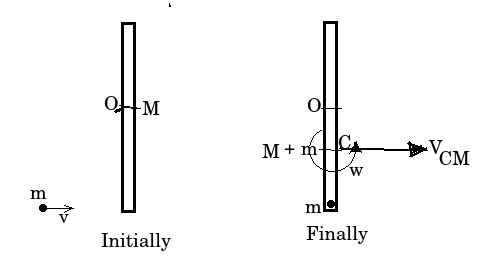Example
Coefficient of restitution
Definition: The coefficient of restitution (COR) is a measure of the "restitution" of a collision between two objects: how much of the kinetic energy remains for the objects to rebound from one another vs. how much is lost as heat, or work done deforming the objects.
Example
Conservation of Momentum in inelastic collision
Example: A body of mass g moving with a velocity of collides with a stationary mass of g. The collision is perfectly inelastic.
Find the percentage loss of kinetic energy of the system.
Solution:
Applying conservation of momentum.
m/s
% loss
%
Find the percentage loss of kinetic energy of the system.
Solution:
Applying conservation of momentum.
m/s
% loss
%
Definition
Elastic collision where one of the mass is very large
Let two masses colliding have mass , initial velocities and final velocities . Let the collision be in one-dimension. Setting without loss of generality.
Then, using conservation of momentum,
Using conservation of energy,
Solving,
Now, since ,
Then, using conservation of momentum,
Using conservation of energy,
Solving,
Now, since ,
Example
One dimensional elastic collision for bodies with equal masses
Question: Two elastic bodies P and Q having equal masses are moving along the same line with velocities of m/s and m/s respectively. What will be their velocities after the elastic collision will be (in m/s)?
Solution:
Let velocities be and
conservation of momentum.
.
The velocities are and
Solution:
Let velocities be and
conservation of momentum.
.
The velocities are and
Example
Velocity of approach and velocity of separation for particles colliding in one dimension
Example: A metal ball falls from a height of 1 m on to a steel plate and jumps upto a height of 81 cm. Find the coefficient of restitution of the ball material.
Solution:Let
Velocity of ball before collision
Velocity of ball after collision
Velocity of plate before collision
Velocity of plate after collision
The coefficient of restitution is given by,
Velocity of separation =
Velocity of approach =
Using
Using
Here, cmcm
Solution:Let
Velocity of ball before collision
Velocity of ball after collision
Velocity of plate before collision
Velocity of plate after collision
The coefficient of restitution is given by,
Velocity of separation =
Velocity of approach =
Using
Using
Here, cmcm
Example
Conservation of Angular Momentum for perfectly inelastic collision of point mass with rigid body

Example: A uniform rod is resting freely over a smooth horizontal plane. A
particle moving horizontally strikes at one end of the rod normally and gets stuck.
Comment on angular momentum of the the system?
Solution: The centre of mass of the rod lies at O initially and that of the system lies at point C finally.
The system (rod + particle) moves translationally with linear velocity
and also rotates about its COM (point C) with an angular
velocity .
Now as net external force is Zero, thus linear momentum is conserved. i.e
Hence COM of system moves translationally with initial momentum of particle.
Also, about all points.Thus angular moment of the system is conserved about all points before and after the collision. (for all points)
particle moving horizontally strikes at one end of the rod normally and gets stuck.
Comment on angular momentum of the the system?
Solution: The centre of mass of the rod lies at O initially and that of the system lies at point C finally.
The system (rod + particle) moves translationally with linear velocity
and also rotates about its COM (point C) with an angular
velocity .
Now as net external force is Zero, thus linear momentum is conserved. i.e
Hence COM of system moves translationally with initial momentum of particle.
Also, about all points.Thus angular moment of the system is conserved about all points before and after the collision. (for all points)
Example
Conservation of momentum in two dimensions

Considering two balls as a system, there isn't any external force acting on them. Momentum will be conserved in either directions along the motion and perpendicular to it.
| BookMarks |
0 Comments
Post a Comment